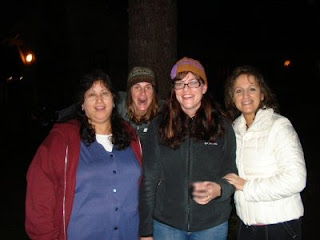Donna was lucky enough to see Western Pearlshell mussels releasing conglutinates.

Jen recently published her first manuscript in River Research and Applications which describes how Bonneville Dam tailwater elevation and seasonal precipitation influence chum salmon spawning activities in tributaries below Bonneville Dam.
Rod shared this: "While I was doing redd surveys this year on the White Salmon River in Washington, I saw what I thought was the biggest tule fall Chinook salmon I've ever seen spawning there. She was deep in a pool and I could only make out her tail, which was white from digging a redd in cobble to put her eggs in. It was a massive tail and I saw the tail dig sideways in the gravel, and could roughly make out her dark silhouette when she was sideways. Several fish attempted to swim into her area of that deep pool and then would bolt away as she chased them off. Easily the highlight of my year."
TAW had 5 highlights including:
-larval pacific lamprey surviving in saline conditions
-observing western pearlshell mussel conglutinates around the fifth of may
-bull trout critical habitat designation being completed
-coauthoring a manuscript that showed how regulating tailwater elevation at Bonneville dam influences chum salmon spawning in tributaries and
-getting a PIT tag antenna in NE Oregon to operate exclusively on solar energy.
Paul got this screw trap out of a NE Oregon stream unscathed:

Don and his crew completed the final report for 5 years worth of research to determine whether Bull Trout from the Walla Walla Basin venture out into the mainstem Columbia River. They do.
Shawna learned how to surgically implant radio tags in bull trout using electronarcosis:

Jeff investigated the salinity tolerance of Pacific lamprey ammocoetes.
Christina completed a first draft of the Pacific Lamprey conservation plan.
Ruby went to see Condit Dam,scheduled to be removed next year, with Howard and his daughter.

Mari's highlight of the year was enjoying the camaraderie at the office retreat.
Maureen PIT tagged a total of 3000 juvenile wild steelhead in Eagle and North Fork Eagle Creeks.
Courtney's highlights included:
- tagging mussels with Donna on a warm summers day
- hiking up the SF Walla Walla River trail to the Bear Creek PIT site and watching rattlesnakes scurry as they got closer, and
- jet boating up the lower Walla Walla River.
In that order.

Henry completed a simulation for Pacific Fishery Management Council that showed that fishing both mark-selective and non-selective fisheries in the same time period and management area would result in an underestimation of unmarked impacts in the non-selective fishery.
In seach of bull trout and deploying temperature loggers Brook, Shawna, and Nichole left the town of Imnaha and ventured 24 miles on a gravel road and stumbled across Hat Point, the high point on the Oregon rim of Hell’s Canyon with the best view of of Hell’s Canyon and the Seven Devils in Eastern Oregon.

David coordinated with other offices and completed the mapping portion of the 2010 Bull Trout Final Critical Habitat.
Trevor will always have fond memories of E-fishing winter steelhead in Eagle creek with Bill, Brian, Sheila, Maureen and the crew for all the double rainbows, sick sticks, trucker talk, big fish screams, laughter, and good times.

In 2010, Marci was able to be a part of moving a bull trout recovery action forward in helping to develop the Clackamas bull trout reintroduction program. Oh - and she also got to get her boots wet occasionally by helping out with Pacific lamprey, coho and coastal cutthroat trout surveys. She simultaneously managed to 1) avoid full body stream immersion, and 2) not get eaten by the insanely large spiders that dominated the forest insect fauna this year. Yahoo!!!
Larry’s highlight was finally getting all of the fish back from the taxidermist and up on the walls.
Bill really enjoyed working with students on Eagle Creek.
Amy's programs helped remove 19 barriers to upstream salmon movements, improved over 14 miles of instream and riparian habitats, and restored 80 acres of tidal wetland. 2010 was a great year in restoration for Oregon's north coast.
I hope you all enjoyed our highlights. 2010 was a great year at the CRFPO! With that, I bid you farewell until next year. Merry Christmas and Happy New Year!
You folks have the best job around! Any openings?
ReplyDelete